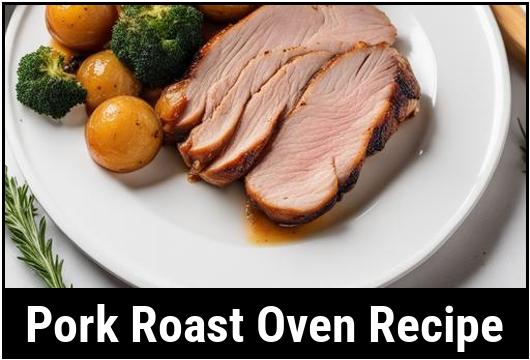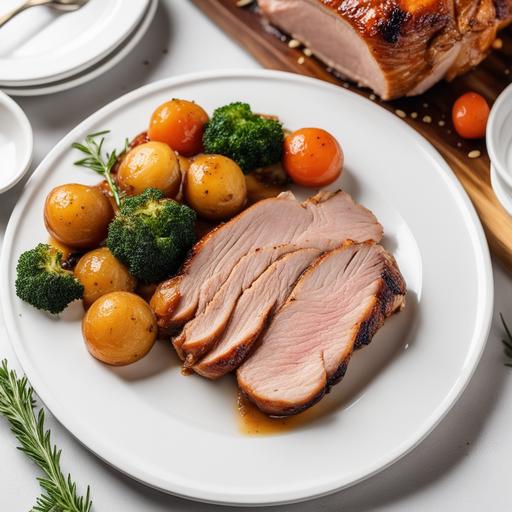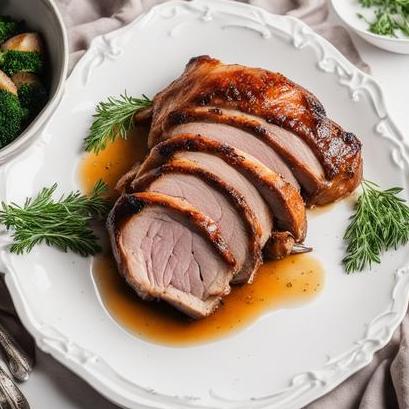- You are here:
- Home »
- Oven Recipes
- » The Ultimate Pork Roast Oven Recipe

The Ultimate Pork Roast Oven Recipe
Unlock the Secrets of Mouthwatering Perfection
There’s an undeniable charm to a beautifully cooked pork roast that fills the air with a delightful aroma and leaves your taste buds craving for more. Whether you’re hosting a special gathering or simply treating yourself to a delicious homemade meal, this comprehensive guide will provide everything you need to know about achieving pork roast perfection right from your oven. From the intricacies of food science to choosing the perfect cut and executing foolproof cooking techniques, let’s embark on a savory journey together.
Food Science and Culinary Details
Before diving into the nitty-gritty of preparing a succulent pork roast, understanding the underlying science and culinary principles is crucial. The pork roast, which typically comes from the loin or shoulder, is composed of muscle fibers, connective tissue, and fat. The desired end result is an ideally tender and juicy roast with well-rendered fat.
When exposed to heat, collagen in the connective tissues breaks down into gelatin, which adds moisture and tenderness to the meat. This transformation occurs during the cooking process through a combination of time, temperature, and the interaction of various compounds.
Selection and Cleaning
To ensure optimal flavor and tenderness, thoughtful selection of your pork roast is paramount. While there are many cuts available, two popular choices are the pork loin and pork shoulder. The loin offers a leaner option, whereas the shoulder is fattier, leading to a richer and more succulent result. Choose a cut that suits your preferences and cooking style.
When it comes to cleaning your pork roast, start by removing it from its packaging and pat it dry with paper towels. This allows for better seasoning adhesion and aids in achieving that coveted, crispy exterior. Remember, cleanliness is key in any culinary endeavor.
Preparation Tips

Proper preparation sets the foundation for a truly exceptional pork roast. Applying the right techniques and flavors will elevate your dish to new heights. Here are some insider tips:
1. Seasoning:
Generously season all sides of your pork roast with a blend of kosher salt, freshly ground black pepper, garlic powder, and any other desired herbs or spices. This develops a depth of flavor that permeates every bite.
2. Resting:
Allow the seasoned roast to rest at room temperature for about 30 minutes before cooking. This allows the flavors to meld, ensuring even cooking throughout.
3. Searing:
For added complexity and texture, sear the pork roast in a hot skillet or Dutch oven before transferring it to the oven. This step creates a caramelized crust that enhances the overall taste experience.
4. Aromatics:
Enhance the aroma and flavor profile of your pork roast by adding aromatics such as sliced onions, minced garlic, fresh herbs, or citrus zest to the roasting pan. These elements infuse the meat with a fragrant essence that is sure to excite your senses.
Variations and Innovative Ideas

While a traditional pork roast is undeniably delicious, exploring unique variations and innovative flavor combinations can take your culinary skills to new heights. Here are a few creative ideas to consider:
1. Asian-inspired Glaze:
Infuse your roast with a blend of soy sauce, ginger, garlic, and honey to create a tantalizingly sweet and savory glaze.
2. Herb-Crusted Roast:
Combine finely chopped fresh herbs, such as rosemary, thyme, and sage, with breadcrumbs and olive oil. Spread this mixture over the top of your pork roast to create a fragrant and crispy crust.
3. Bacon-Wrapped Delight:
Indulge your taste buds with a decadent twist by wrapping your pork roast in strips of smoky bacon before roasting. This imparts irresistible flavors and adds an extra layer of juiciness.
Doneness Checks: Achieving Pork Perfection

Determining the doneness of your pork roast is a crucial step towards delivering a memorable meal. To ensure optimal results, use a meat thermometer to gauge the internal temperature. Insert the thermometer into the thickest part of the roast while avoiding contact with the bone.
For a juicy, slightly pink interior, aim for an internal temperature of 145°F (63°C), followed by a resting period of 3-5 minutes. If you prefer your pork more well-done, increase the temperature to 160°F (71°C). It’s important to strike the right balance—neither undercooking nor overcooking your precious roast.
The Perfect Recipe: Oven-Roasted Pork Loin

Now, let’s dive into a tried-and-true recipe that will have your family and friends eagerly gathering around the dinner table.
Ingredients:
-
1 (3-4 pound) boneless pork loin roast
-
2 teaspoons kosher salt
-
1 teaspoon freshly ground black pepper
-
2 teaspoons garlic powder
-
1 tablespoon olive oil
-
Optional: fresh herbs (rosemary, thyme, etc.)
Instructions:
-
Preheat your oven to 375°F (190°C).
-
Prepare your pork loin by patting it dry with paper towels.
-
In a small bowl, combine the salt, black pepper, and garlic powder. Sprinkle the mixture evenly over all sides of the pork roast.
-
Heat olive oil in an oven-safe skillet or Dutch oven over medium-high heat. Sear the pork roast until browned on all sides, approximately 2-3 minutes per side.
-
If desired, add fresh herbs such as rosemary or thyme to the pan for added fragrance.
-
Transfer the skillet or Dutch oven to the preheated oven and continue cooking for 18-20 minutes per pound or until the internal temperature reaches 145°F (63°C).
-
Remove the pork roast from the oven and let it rest for 3-5 minutes before slicing.
-
Slice the roast into thin, succulent pieces and serve it alongside your favorite side dishes.
Overcooking or Undercooking Concerns
When it comes to pork roast, finding the sweet spot between undercooking and overcooking can be challenging. Overcooking can result in a dry, tough roast, while undercooking poses potential health risks. However, armed with a meat thermometer and the knowledge provided here, you can confidently achieve the perfect balance.
If you happen to slightly overcook your roast, don’t despair! Utilize flavorful sauces or gravies to add moisture to the dish. Additionally, thinly slicing the meat against the grain can help mitigate any inadvertent dryness.
Conclusion
A well-executed pork roast is a culinary masterpiece, requiring patience, precision, and a dash of expertise. Armed with the knowledge garnered from this comprehensive guide, you possess all the tools necessary to create the ultimate pork roast with confidence.
Remember, select the finest cuts, skillfully season and prepare your roast, experiment with variations to tantalize your taste buds, and most importantly, strive for the perfect doneness. With practice and plenty of delicious experiments, you’ll soon have friends and family begging for your famous pork roast recipe. So, preheat that oven, gather your ingredients, and let the journey towards pork roast perfection begin!
Sources
FAQS On Pork Roast Oven Recipe
What Cut Of Pork Should I Use For A Pork Roast Oven Recipe?
For a pork roast oven recipe, you should use a boneless pork loin roast, which is tender and flavor-packed. This cut is ideal for oven roasting as it cooks evenly and retains juiciness, resulting in a succulent and delicious pork roast.
How Should I Prepare The Pork Roast Before Cooking It In The Oven?
Before cooking the pork roast in the oven, it is best to season it with a marinade or rub of your choice. This helps to enhance the flavors and tenderize the meat. You can marinate the pork overnight or for a few hours before roasting, or simply season it with a dry rub just before cooking. Additionally, you can let the pork roast come to room temperature for about 30 minutes before placing it in the preheated oven.
What Is The Recommended Oven Temperature And Cooking Time For A Pork Roast?
To achieve the perfect pork roast, preheat your oven to 350°F (175°C) for a traditional roast, or 375°F (190°C) for a slightly crispier outer layer. The cooking time will vary depending on the size of the pork roast. As a general rule of thumb, you should cook the roast for about 25-30 minutes per pound (500g) of meat. It is crucial to use a meat thermometer to check the internal temperature, which should reach 145°F (63°C) at its thickest part.
Should I Cover The Pork Roast While It Cooks In The Oven?
Covering the pork roast depends on personal preference. If you want a crispier outer layer, leave the pork roast uncovered. However, if you prefer a more tender and moist roast, covering it loosely with aluminum foil during the first part of the cooking process helps retain moisture. Remove the foil for the last 15-20 minutes of cooking to allow the top to crisp up.
How Do I Know If The Pork Roast Is Fully Cooked And Ready To Be Served?
To ensure that the pork roast is fully cooked and safe to eat, use a meat thermometer to check its internal temperature. Insert the thermometer into the thickest part of the roast, being careful not to touch the bone. The pork roast should reach an internal temperature of 145°F (63°C). Once the desired temperature is reached, remove the roast from the oven and let it rest for about 10-15 minutes, allowing the juices to redistribute throughout the meat before slicing and serving.


